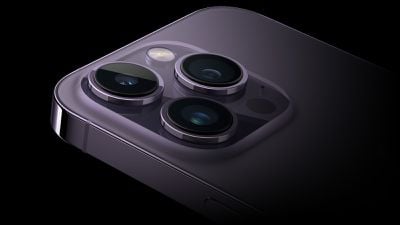iPhone 15 Pro Models Again Rumored to Feature Improved LiDAR Scanner
Apple's next-generation iPhone 15 Pro and iPhone 15 Pro Max are once again rumored to feature an improved LiDAR Scanner supplied by Sony.

In a research note shared with investors this week, Barclays analysts Blayne Curtis and Tom O'Malley said Sony could supply the majority, if not all, of LiDAR Scanner components for the iPhone 15 Pro models launching later this year.
Sony could take a majority, if not all, of the share on the world facing sensor in this years' models with the company providing a module, VCSEL, receiver and driver. This is a negative headwind to both LITE and COHR which we view as likely.
Apple analyst Ming-Chi Kuo last month said Sony would replace Lumentum and WIN Semiconductors as the exclusive supplier of LiDAR Scanner components for the iPhone 15 Pro models. Kuo said Sony's solution is more power efficient and could result in the LiDAR Scanner offering improved performance at the same level of power consumption as now, or equal performance with less of an impact on battery life.
Introduced on iPhone 12 Pro models in 2020, the LiDAR Scanner can measure light distance and capture depth information, and the hardware is expected to remain exclusive to iPhone 15 Pro models. An improved LiDAR Scanner could be beneficial to augmented reality apps, Night mode photos, and camera autofocus.
Other rumored iPhone 15 Pro features include an A17 Bionic chip, a USB-C port, a titanium frame with solid-state buttons, thinner bezels around the display, and more.
Popular Stories
Since the iPhone X in 2017, all of Apple's highest-end iPhone models have featured either stainless steel or titanium frames, but it has now been rumored that this design decision will be coming to an end with the iPhone 17 Pro models later this year.
In a post on Chinese social media platform Weibo today, the account Instant Digital said that the iPhone 17 Pro models will have an aluminum...
Apple should unveil the iPhone 17 series in September, and there might be one bigger difference between the Pro and Pro Max models this year.
As always, the Pro Max model will be larger than the Pro model:iPhone 17 Pro: 6.3-inch display
iPhone 17 Pro Max: 6.9-inch displayGiven the Pro Max is physically larger than the Pro, it has more internal space, allowing for a larger battery and...
Apple is continuing to refine and update iOS 26, and beta three features smaller changes than we saw in beta 2, plus further tweaks to the Liquid Glass design. Apple is gearing up for the next phase of beta testing, and the company has promised that a public beta is set to come out in July.
Transparency
In some apps like Apple Music, Podcasts, and the App Store, Apple has toned down the...
The calendar has turned to July, meaning that 2025 is now more than half over. And while the summer months are often quiet for Apple, the company still has more than a dozen products coming later this year, according to rumors.
Below, we have outlined at least 15 new Apple products that are expected to launch later this year, along with key rumored features for each.
iPhone 17 Series
iPho...
In 2020, Apple added a digital car key feature to its Wallet app, allowing users to lock, unlock, and start a compatible vehicle with an iPhone or Apple Watch. The feature is currently offered by select automakers, including Audi, BMW, Hyundai, Kia, Genesis, Mercedes-Benz, Volvo, and a handful of others, and it is set to expand further.
Apple has a web page with a list of vehicle models that ...
Apple's next-generation iPhone 17 Pro and iPhone 17 Pro Max are just over two months away, and there are plenty of rumors about the devices.
Below, we recap key changes rumored for the iPhone 17 Pro models.
Latest Rumors
These rumors surfaced in June and July:Apple logo repositioned: Apple's logo may have a lower position on the back of the iPhone 17 Pro models, compared to previous...
New renders today provide the best look yet relocated Apple logo and redesigned MagSafe magnet array of the iPhone 17 Pro and iPhone 17 Pro Max.
Image via Majin Bu.
Several of the design changes coming to the iPhone 17 Pro model have been rumored for some time, such as the elongated camera bump that spans the full width of the device, with the LiDAR Scanner and flash moving to the right side.
...
iPhone 17 models will feature a redesigned Dynamic Island user interface, according to a post today from Digital Chat Station, an account with more than three million followers on Chinese social media platform Weibo. The account has accurately leaked some information regarding future Apple products in the past.
The account did not share any specific details about the alleged changes that are ...
Apple is expanding the ability to add an Apple Account Card to the Wallet app to more countries, according to backend Apple Pay changes.
With iOS 15.5, Apple updated the Wallet app to allow users to add an Apple Account Card, which displays the Apple credit balance associated with an Apple ID.
If you receive an Apple gift card, for example, it is added to an Apple Account that is also...






















